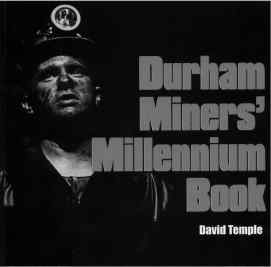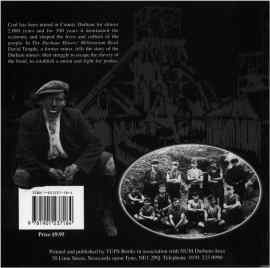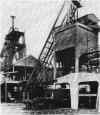
Durham Miners Millennium Book
David Temple
pub: TUPS Books In Association with the NUM Durham Area.
ISBN 1-901237-18-4
£9.95.
30 Lime Street. Newcastle Upon Tyne. NE1 2 PQ
 |
The presentation of this book, with dynamic frontage and jam packed full
of fascinating photos gives a hint as to the quality of its content, even
before you set off reading it , one is not disappointed. A concise history
of the geology and coal work of the region sets the backdrop to a social
and economic history. Much of this history is well known to Northumberland
and Durham mining folk, having being taught it from the cradle and generation
to generation. It has often been said that bairns in pit villages didn't
get bedtime stories about Goldilocks and The Three Bears, but rather those
of Churchill and the 26 Strike, or The Life of Martin Jude. With the demise
of mining in these coalfields it had been feared this history, would be
lost to all but academics. Hopefully this book, by retelling its key components
in such an attractive and colourful presentation will ensure this knowledge
continues. Certainly this is the most comprehensive yet entirely readable
and comprehensive book I have yet seen about the Durham miners.
(Click on thumbnail images to enlarge)
|
"Richard Fynes in his History of the Northumberland
and Durham Miners refers to a miner living in the Hetton area at
this time by the name of Mackintosh: |
The books takes us through distant origins of our trade , to early demands
and riots, the birth of The Ranters, and Methodism as a mass working class
spiritual and social movement. The origins of radical politics , armed
resistance early mining brotherhoods , the war against ‘The Bond’
and the nie impossible heroism of impoverished pit folk over generations
of struggles for justice.
|
"When life could be taken away in the flash of a methane explosion or the sudden collapse of a faulted roof, miners lived the moment" |
The book reminds us of the immense size of the Durham coalfield which
touched virtually every family in the county, The Durham Miners Association
having a membership of 121,805 in 1910, reaching a peak in 1913 with 166,000
men employed in the coalfield.
|
"...... on 21 March , twenty
thousand pitmen met on the Town Moor, Newcastle, where they passed
a number of resolutions calling for higher pay and a reduction in
the hours of work for children."
|
It records the massive national strike of 1912 when 800,000 miners came
out "It was the first day of the biggest strike in British history,
in which a total of one million men were soon out".
|
"Haswell Colliery
circa 1880s" |
There are some wonderful anecdotes too numerous to mention as the history
unfolds but a couple of examples must be included here, :- In the election
held on 27 Oct. 1931, Mac Donald stood against the Labour candidate, W
Coxon, in Seaham and held his seat with a reduced majority of 6,000. George
Lumley, who was then a members of the DMA Executive Committee invited
the wrath of the Durham Agents by standing in the election as the Communist
candidate, thus opposing the official DMA nominee, Coxon. As a result
Lumley will forever occupy a special place in history as the only Durham
miner to stand in election against a prime minister.
"An explosion ar West Stanley colliery on 16 February 1909 claimed the lives of 168 men and boys. Frank Keegan, the miners local inspector was acclaimed a hero for his part in rescuing 26 men." Frank Keegan was the grandfather of one-time England football manager, Kevin Keegan. |
The second is about the hated coal owner Lord Londonderry :- "Londonderry pursued his political career in other directions and became a personal friend of Hitler, whom he was fond of visiting. He was so enthusiastic about developments in Germany that he wrote a Penguin Special entitled Ourselves and Germany arguing that it was in Britain’s interests to extend a hand of friendship to Hitler. Less than a decade later, when the Russian army took Berlin they found his little book in Hitler's bunker, bearing the author’s inscription:
To the Fuhrer with my best wishes and the most serious hope for the
best and most long lasting mutual understanding between our two countries.
|
|
"Fishburn Colliery circa 1920" |
And one other :-
"Vesting Day 1st January 1947 the day the mining industry passed
from private ownership to state ownership. Expectations were high. The
coal owners who had ruled the lives of thousands upon thousands of miners
families for generations, ceased to rule. The newly established Northern
Division Coal Board (Durham, Northumberland and Cumberland) became responsible
overnight for more than 200 pits and attached workings, together with
44,000 colliery houses, 200 firms, 100,000 acres of land, 18 coking plants
in Durham, several brickwork's, over 100 local electricity systems and
‘miscellaneous items’ including a mortuary, a fish and chip
shop and a public house".
|
|
"Chilton lodge, setting out for Gala 1940s" |
The author, David Temple a life long mineworker and Union militant deserves
every praise possible for this truly excellent work. The end of the story
we all know, what strikes you deeply and emotionally as you chart the
history of this great people, is that they did not deserve this end. If
there was any justice, or if flesh , blood and human endeavour meant anything
there ought to have been a different end to this story. On reflection
perhaps the end has yet to written, as Durham Gala crowds continue to
rebuild, and as more and more of the old banners return each year, it
is clear this movement was never just about holes in the ground. It was
about collective struggle, solidarity and identity of class culture and
history these and still very much in evidence , in conditions in many
ways more difficult than we have ever had to confront.
 |









